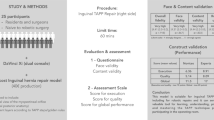Abstract
Purpose
Assess the utility of a hands-on cadaver workshop for teaching abdominal wall reconstruction (AWR) using components separation technique.
Methods
Over a year, from June 2022 to July 2023, 112 surgeons participated in seven training courses focused on the eTEP technique for inguinal and ventral hernias. The workshops covered theoretical learning sessions followed by hands-on training using frozen human cadavers. An online survey was used to know the influence of our workshop on the clinical practice of the attendees.
Results
Out of 112 total participants, 70% (78) participants completed the survey. Among them, 58% (45) surgeons had over 10 years of experience. The workshop resulted in approximately 85% (66) of participants successfully adapting to eTEP. Confidence levels significantly increased for all steps of the technique after the workshop (p < 0.001, Rank-Biserial Correlation = −1.000). Participants expressed high satisfaction with the course.
Conclusion
The cadaver model training program was found to be effective in reducing the learning curve and being replicable. This suggests its potential for widespread implementation as an introductory training model for learning the anatomy of abdominal wall and adapting this for treating hernias requiring AWR.













Similar content being viewed by others
Data availability
The data will be made available based on reasonable request.
References
Pahwa HS (2015) Current trends in laparoscopic groin hernia repair: A review. WJCC 3:789
Nanayakkara KDL, Viswanath NG, Wilson M et al (2023) An international survey of 1014 hernia surgeons: outcome of GLACIER (global practice of inguinal hernia repair) study. Hernia. https://doi.org/10.1007/s10029-023-02818-8
The HerniaSurge Group (2018) International guidelines for groin hernia management. Hernia 22:1–165. https://doi.org/10.1007/s10029-017-1668-x
Daes J (2012) The enhanced view–totally extraperitoneal technique for repair of inguinal hernia. Surg Endosc 26:1187–1189. https://doi.org/10.1007/s00464-011-1993-6
Ramirez OM, Ruas E, Dellon AL (1990) Components separation method for closure of abdominal-wall defects: an anatomic and clinical study. Plast Reconstr Surg 86:519–526. https://doi.org/10.1097/00006534-199009000-00023
Poulose BK (2016) Transversus abdominis muscle release. Ann Surg 264(2):233–234. https://doi.org/10.1097/SLA.0000000000001734
Novitsky YW, Fayezizadeh M, Majumder A et al (2016) Outcomes of posterior component separation with transversus abdominis muscle release and synthetic mesh sublay reinforcement. Ann Surg 264:226–232. https://doi.org/10.1097/SLA.0000000000001673
Belyansky I, Daes J, Radu VG et al (2018) A novel approach using the enhanced-view totally extraperitoneal (eTEP) technique for laparoscopic retromuscular hernia repair. Surg Endosc 32:1525–1532. https://doi.org/10.1007/s00464-017-5840-2
Radu VG, Lica M (2019) The endoscopic retromuscular repair of ventral hernia: the eTEP technique and early results. Hernia 23:945–955. https://doi.org/10.1007/s10029-019-01931-x
Novitsky YW, Elliot HL, Orenstein SB, Rosen MJ (2012) Tranversus abdominis muscle release: a novel approach to posterior component separation during complex abdominal wall reconstruction. Am J Surg 204:709–716. https://doi.org/10.1016/j.amjsurg.2012.02.008
Penchev D, Kotashev G, Mutafchiyski V (2019) Endoscopic enhanced-view totally extraperitoneal retromuscular approach for ventral hernia repair. Surg Endosc 33(11):3749–3756. https://doi.org/10.1007/s00464-019-06669-2
Ramana B, Arora E, Belyansky I (2021) Signs and landmarks in e-tep rives-stoppa repair of ventral hernias. Hernia 25:545–550. https://doi.org/10.1007/s10029-020-02216-4
Misra MC, Krishna A, Baksi A, Bansal VK (2019) Teaching and learning of laparoendoscopic hernia surgery in India: a challenge - problems and solutions. Int J Abdom Wall Hernia Surg 2:63–69. https://doi.org/10.4103/ijawhs.ijawhs_10_19
Mahadar R, Arora E (2021) Trocar insertion in enhanced-view totally extra-peritoneal (eTEP) repair of inguinal hernias. J Min Access Surg 17:580. https://doi.org/10.4103/jmas.JMAS_312_20
Deerenberg EB, Harlaar JJ, Steyerberg EW et al (2015) Small bites versus large bites for closure of abdominal midline incisions (STITCH): a double-blind, multicentre, randomised controlled trial. The Lancet 386:1254–1260. https://doi.org/10.1016/S0140-6736(15)60459-7
McCormack K, Scott N, Go PMNYH et al (2003) Laparoscopic techniques versus open techniques for inguinal hernia repair. Cochrane Database Syst Rev. https://doi.org/10.1002/14651858.CD001785
Daes J (2019) Minimally Invasive Surgical Techniques for Inguinal Hernia Repair: The Extended-View Totally Extraperitoneal Approach (eTEP). In: Dakin G, Bates A (eds) Davis Jr S Scott. The SAGES Manual of Hernia Surgery. Springer International Publishing, Cham, pp 449–460
Azevedo MA, Santos HMG, Oliveira GBTD et al (2021) Training model in abdominal wall endoscopic surgery for ventral hernias. Extended totally extra-peritoneal approach (e-tep). Acta Cir Bras. https://doi.org/10.1590/acb360808
Sharma M, Horgan A (2012) Comparison of fresh-frozen cadaver and high-fidelity virtual reality simulator as methods of laparoscopic training. World J Surg 36:1732–1737. https://doi.org/10.1007/s00268-012-1564-6
Pal AK, Bhanarkar UP, Ray B (2022) Embalming with Formalin – Benefits and Pitfalls. Sch Int J Anat Physiol 5:70–77
Acknowledgements
Special thanks to Dr. Sangeeta Ravat, Dean, Seth GSMC and KEM Hospital and Dr. Sujata Patwardhan, Director ROTTO SOTTO and Head of Department, Urology, Seth GSMC and KEM Hospital for their support.
Author information
Authors and Affiliations
Corresponding author
Ethics declarations
Conflict of interest
The authors A.G., J.G., R.P., R.M., R.S., S.C., P.S., Y.P. and B.T. declare they have no conflicts of interest.
Ethical approval
Approval from the institutional review board was not required for this study.
Additional information
Publisher's Note
Springer Nature remains neutral with regard to jurisdictional claims in published maps and institutional affiliations.
Rights and permissions
Springer Nature or its licensor (e.g. a society or other partner) holds exclusive rights to this article under a publishing agreement with the author(s) or other rightsholder(s); author self-archiving of the accepted manuscript version of this article is solely governed by the terms of such publishing agreement and applicable law.
About this article
Cite this article
Gajjar, A., Gandhi, J., Prajapati, R. et al. Impact of cadaver training for learning abdominal wall reconstruction: our early experience. Hernia 28, 85–95 (2024). https://doi.org/10.1007/s10029-023-02907-8
Received:
Accepted:
Published:
Issue Date:
DOI: https://doi.org/10.1007/s10029-023-02907-8




